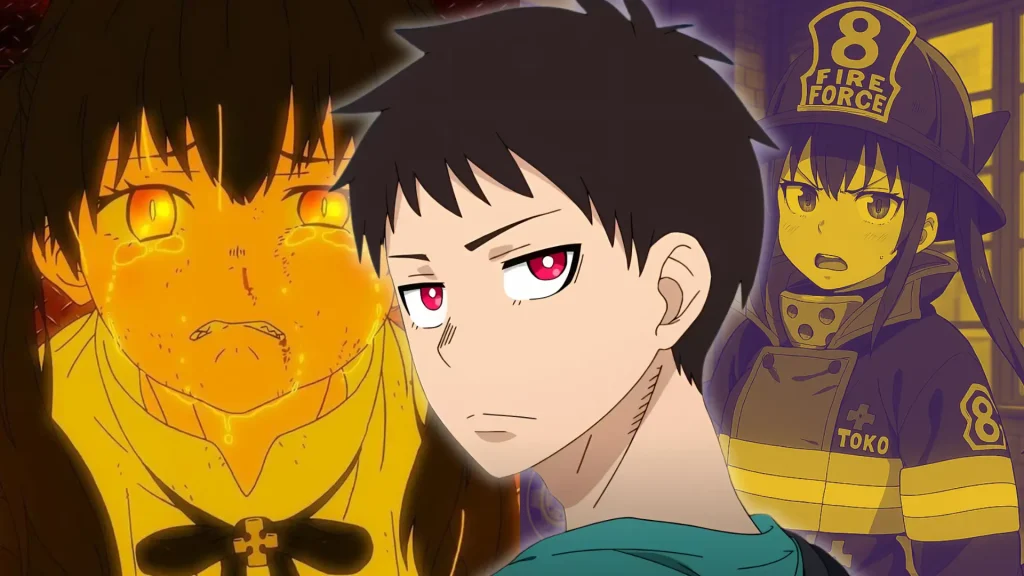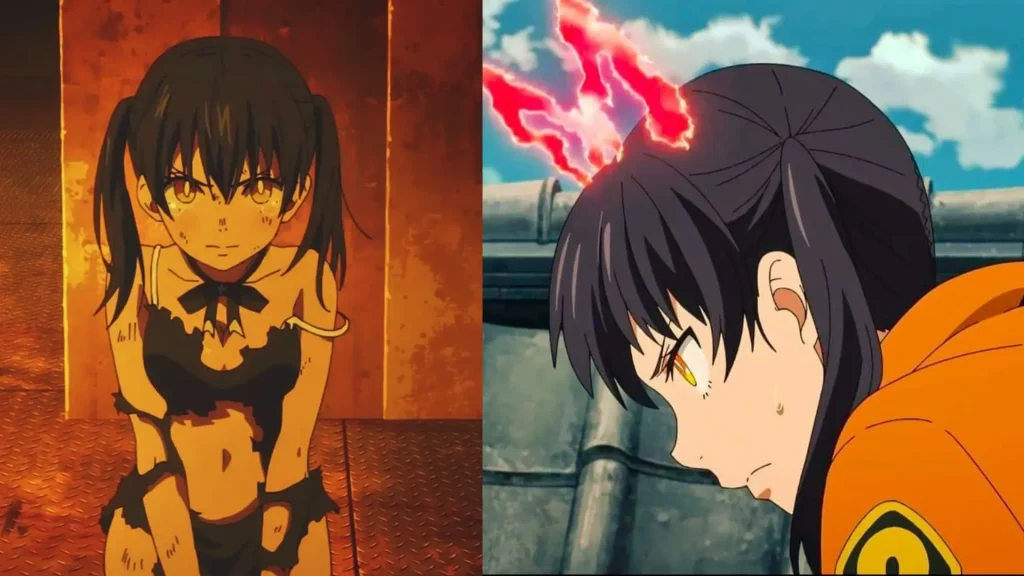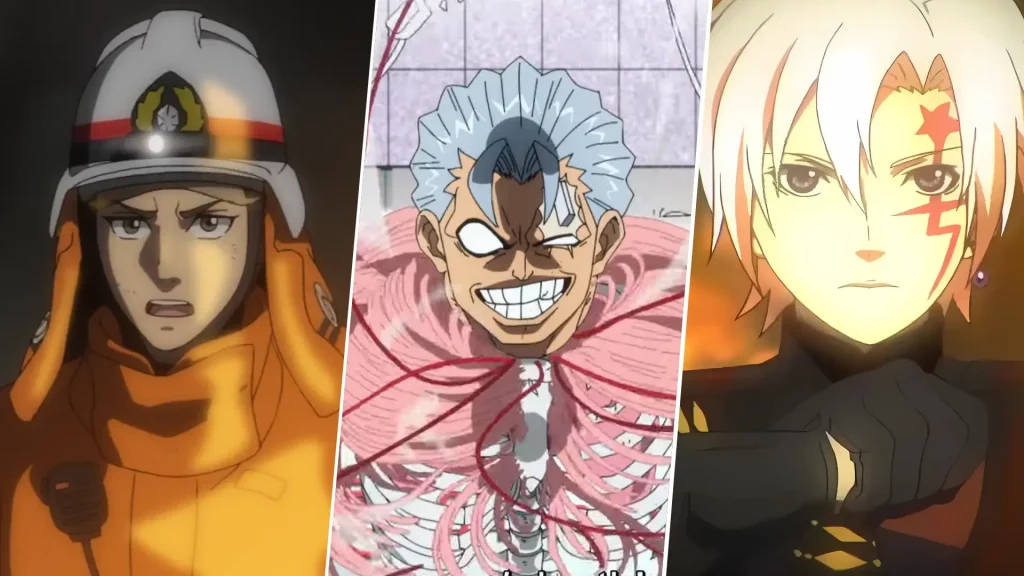If you’ve ever tried recommending Fire Force to someone new to anime, chances are you’ve followed up your praise with a disclaimer: “The action is amazing, the animation is top-tier, but… yeah, there’s some fan service. A lot of it.” And for a good chunk of the audience, especially those not steeped in anime culture, that’s where the friction starts. But here’s the kicker: that fan service? It’s not an accident. And it might just be one of the reasons the show works as well as it does.

Fire Force is known for: fan service. Lots of it. And not in the background, it’s right there, center stage, often crashing into otherwise serious moments like a slapstick intermission during a tragedy.
For many fans, this sharp contrast is either the show’s greatest flaw, or one of its defining strengths. And here’s the real truth: that absurd fan service is not just a sideshow. It’s a deliberate part of Fire Force’s identity, and a big reason why it stands out in a crowded field of shonen anime.
The Tamaki Factor
You can’t talk about Fire Force’s fan service without talking about Tamaki Kotatsu. From the moment she’s introduced, Tamaki is surrounded by chaos, not the fiery kind, but the kind that rips her clothes, tosses her into suggestive positions, and turns every battle into a potential wardrobe malfunction.

Her “Lucky Lecher Lure,” an actual in-universe trait, ensures that she constantly ends up in sexually charged accidents. It’s not subtle. It’s not occasional. It’s a recurring gag that defines her character for better or worse.
There are moments where the tone of the show completely shifts because of her. One of the most infamous examples comes during a serious battle between Shinra and Lieutenant Rekka. The tension is high, the stakes are deadly, and then Tamaki crashes into the fight, trips, and ends up in her underwear. The moment drags on for nearly a full minute, killing the suspense and replacing it with sheer absurdity.
It’s easy to understand why this would annoy people. For some viewers, especially those unfamiliar with anime’s more over-the-top humor, this kind of fan service feels out of place, even disrespectful to the story. The shift in tone is jarring, and Tamaki’s constant mishaps can feel like they reduce her to a walking punchline with no room for depth.
But It’s Supposed to Be Like That
Here’s the thing: Fire Force knows exactly what it’s doing. The fan service isn’t lazily shoved into the script, it’s woven into the show’s DNA as a form of intentional slapstick comedy. The way characters react to Tamaki’s accidents isn’t through ogling or flirty banter, it’s with exasperation, embarrassment, and groans of frustration. “Not again” becomes the expected reaction. That’s the real joke.
It’s not about titillation. It’s about chaos. Her mishaps are exaggerated to the point of parody. Clothes combust out of nowhere. Entire action sequences are derailed because someone tripped into a suggestive pose.
And most importantly, the fan service doesn’t feel like it’s supposed to be taken seriously. It’s not the male gaze, it’s a fire-hose of comic relief sprayed directly into the middle of grim, emotional storylines.
A Pressure Valve in a Dark World

It’s easy to forget, but Fire Force is a pretty bleak show under the hood. People randomly combust into monstrous infernals. Death is frequent and rarely gentle. Themes of trauma, existential fear, and grief swirl beneath the action.
The inclusion of over-the-top, dumb comedy, yes, including panty shots, isn’t just a stylistic quirk. It’s a pressure valve. The fan service gives the audience a moment to breathe, to laugh at how absurd everything is, before diving back into the flames.
And if you look at creator Atsushi Ōkubo’s past work, especially Soul Eater, you’ll see a similar pattern. Dark settings, heavy themes, and a streak of bizarre, often juvenile humor. But Fire Force takes it even further, leaning into the extremes, darker plotlines and goofier gags. It’s a cocktail that doesn’t work for everyone, but for the fans who love it, that contrast is part of the thrill.
Tamaki’s Fan Service Isn’t Just a Gag, It Becomes a Statement

Tamaki’s infamous Lucky Lecher Lure is often cited as a cheap gimmick, but the show actually addresses it in-universe. In one late arc from the manga (Chapter 280, during the final battle), Tamaki doesn’t reject her fan service label, she embraces it.
She literally says she’s going to “save the world with the power of sex appeal.” It’s not subtle, but it’s also not a throwaway line. It’s the creator making a statement: “Yes, this is what this character is about. Deal with it.”
And Tamaki isn’t the only example. There’s the arc where a villain named Assault is rendered completely useless by Tamaki’s accidental exposure. He becomes so traumatized by her that he starts a bizarre training regimen to try and desensitize himself. It’s pure nonsense, fully self-aware, and again, completely absurd on purpose.
Fan Service Isn’t Just Accepted, It Sells
Whether you love it or hate it, the numbers speak for themselves. Fire Force has sold over 20 million copies of its manga. The anime has multiple seasons, games, and a steady merch line. The show’s willingness to lean into controversy, to push boundaries of taste and tone, has helped it carve out a unique spot in anime culture.
Fan service is common across shonen anime. One Piece uses it with characters like Nami and Robin. My Hero Academia has Midnight and Mount Lady. Fairy Tail practically built its identity on it, with creator Hiro Mashima openly admitting that he includes fan service simply because he enjoys it. And for a lot of fans, that honesty and boldness only makes the series more fun.
Fire Force just happens to be one of the few that doesn’t try to hide behind subtext. It puts fan service front and center, sometimes to the show’s detriment, but always with full awareness of what it’s doing.
Could the Show Work Without It?
Technically, yes. But it wouldn’t be Fire Force.
Take away the bikini nun, the impromptu strip gags, and Tamaki’s never-ending stream of wardrobe disasters, and you lose part of what makes the show feel so chaotic and unpredictable. That sharp tonal whiplash is part of the appeal. One moment, the world is ending in fire. The next, someone’s bra is on fire instead. It’s messy, weird, and totally unique.
And that unpredictability keeps fans talking. Whether it’s frustration, laughter, or outrage, it’s attention. And in a sea of anime all fighting for relevance, Fire Force stands out because of its extremes.
My Final Thoughts
Fire Force isn’t afraid to be dumb. It’s not scared of leaning too hard into its weirdness. And yes, it unapologetically uses fan service, often, and loudly. But it’s not lazy. It’s calculated, exaggerated, and self-aware to the point of parody. It makes you laugh, groan, and shake your head all at once.
And in a medium where so many shows play it safe, Fire Force goes all in on being chaotic, horny, stylish, and just plain weird.
You might watch it for the fire-fueled superpowers, but don’t be surprised if you stick around because you can’t believe what you’re watching. And that’s the spark that keeps this anime burning.

